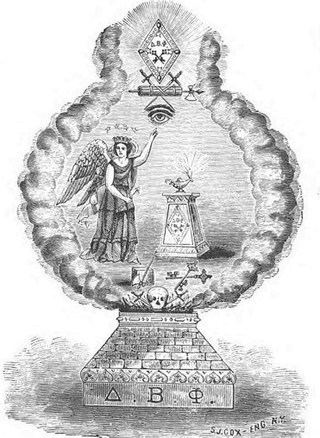
A cloak is a type of loose garment worn over clothing, mostly but not always as outerwear for outdoor wear, serving the same purpose as an overcoat, protecting the wearer from the weather. It may form part of a uniform. People in many different societies may wear cloaks. Over time cloak designs have changed to match fashion and available textiles.

The toga, a distinctive garment of ancient Rome, was a roughly semicircular cloth, between 12 and 20 feet in length, draped over the shoulders and around the body. It was usually woven from white wool, and was worn over a tunic. In Roman historical tradition, it is said to have been the favored dress of Romulus, Rome's founder; it was also thought to have originally been worn by both sexes, and by the citizen-military. As Roman women gradually adopted the stola, the toga was recognized as formal wear for male Roman citizens. Women found guilty of adultery and women engaged in prostitution might have provided the main exceptions to this rule.

The stola was the traditional garment of Roman women, corresponding to the toga that was worn by men. It was also called vestis longa in Latin literary sources, pointing to its length.

Kappa Alpha Theta (ΚΑΘ), commonly referred to simply as Theta, is an international women’s fraternity founded on January 27, 1870, at DePauw University in Greencastle, Indiana. It was the first Greek-letter fraternity established for women. The fraternity was founded by four female students, Bettie Locke Hamilton, Alice Allen Brant, Bettie Tipton Lindsey, and Hannah Fitch Shaw. The organization has 147 chapters at colleges and universities in the United States and Canada. The organization was the first women's fraternity to establish a chapter in Canada. Theta's total living initiated membership, as of 2020, was more than 250,000. There are more than 200 alumnae chapters and circles worldwide.

The North American Interfraternity Conference is an association of intercollegiate men's social fraternities that was formally organized in 1910, although it began at a meeting at the University Club of New York on November 27, 1909. The power of the organization rests in a House of Delegates in which each member fraternity is represented by a single delegate. However, the group's executive and administrative powers are vested in an elected board of directors consisting of nine volunteers from various NIC fraternities. Headquartered in Indianapolis, Indiana, the NIC has a small professional staff.

Phi Kappa Theta (ΦΚΘ), commonly known as Phi Kap, is a national social fraternity that has over 35 active chapters and colonies at universities across 21 U.S. states. The fraternity was founded on April 29, 1959, at Ohio State University in Columbus, Ohio, with the agreed-upon merger of two older Catholic fraternities, Phi Kappa and Theta Kappa Phi. Phi Kappa was founded exactly 70 years prior in 1889 at Brown University in Providence, Rhode Island, while Theta Kappa Phi was founded later in October 1919 at Lehigh University in Bethlehem, Pennsylvania.
Dartmouth College is host to many fraternities and sororities, and a significant percentage of the undergraduate student body is active in Greek life. In 2005, the school stated that 1,785 students were members of a fraternity, sorority, or gender-inclusive Greek house, comprising about 43 percent of all students, or about 60 percent of the eligible student body. Greek organizations at Dartmouth provide both social and residential opportunities for students and are the only single-sex residential option on campus. Greek organizations at Dartmouth do not provide dining options, as regular meal service has been banned in Greek houses since 1909.

The blanket sleeper is a type of especially warm sleeper or footie pajama worn primarily during the winter in the United States and Canada. The garment is worn especially by young children.

Acacia Fraternity, Inc. is a social fraternity founded in 1904 at the University of Michigan in Ann Arbor, Michigan. The fraternity has 27 active chapters and 3 associate chapters throughout Canada and the United States. The fraternity was founded by undergraduate Freemasons and was originally open only to men who had taken the Masonic obligations, but in 1933 the International Conclave elected to dispense with the Masonic prerequisite. In 1988, at the 45th Conclave, the fraternity elected to use "International" rather than "National" when referring to the fraternity.
While the traditional social fraternity is a well-established mainstay across the United States at institutions of higher learning, alternatives – in the form of social fraternities that require doctrinal and behavioral conformity to the Christian faith – developed in the early 20th century. They continue to grow in size and popularity.
The Mother of Fraternities usually refers to Union College or Miami University, both of which founded many early collegiate fraternities.

Sigma Theta Epsilon (ΣΘΕ) was an interdenominational national Christian fraternal organization whose last active chapter appears to have ceased operations in 2022. Its first name as an emerging national fraternity was Delta Sigma Theta in November 1941, but due to the threat of a lawsuit over that name by a sorority with prior use, in April 1949 the new name, Sigma Theta Epsilon Christian Fraternity, was chosen. Sigma Theta Epsilon traces its history from Phi Tau Theta (local)'s founding in April 7, 1925 at Lincoln, Nebraska and Sigma Epsilon Theta (local)'s founding on October 8, 1936 at Indiana University.
Phi Tau Theta (ΦΤΘ) was a national religious fraternity for Methodist men which through name changes and mergers became part of Sigma Theta Epsilon.

Clothing in ancient Rome generally comprised a short-sleeved or sleeveless, knee-length tunic for men and boys, and a longer, usually sleeved tunic for women and girls. On formal occasions, adult male citizens could wear a woolen toga, draped over their tunic, and married citizen women wore a woolen mantle, known as a palla, over a stola, a simple, long-sleeved, voluminous garment that modestly hung to cover the feet. Clothing, footwear and accoutrements identified gender, status, rank and social class. This was especially apparent in the distinctive, privileged official dress of magistrates, priesthoods and the military.

The preservation of fabric fibers and leathers allows for insights into the attire of ancient societies. The clothing used in the ancient world reflects the technologies that these peoples mastered. In many cultures, clothing indicated the social status of various members of society.
The North American fraternity and sorority system began with students who wanted to meet secretly, usually for discussions and debates not thought appropriate by the faculty of their schools. Today they are used as social, professional, and honorary groups that promote varied combinations of community service, leadership, and academic achievement.
The term Triad is used to designate certain historic groupings of seminal college fraternities in North America.
In North America, fraternities and sororities are social organizations at colleges and universities. They are sometimes collectively referred to as Greek life. Generally, membership in a fraternity or sorority is obtained as an undergraduate student but continues thereafter for life. Some accept graduate students as well. Individual fraternities and sororities vary in organization and purpose, but most share five common elements:
- Secrecy
- Single-sex membership
- Selection of new members based on a two-part vetting and probationary process known as rushing and pledging
- Ownership and occupancy of a residential property where undergraduate members live
- A set of complex identification symbols that may include Greek letters, armorial achievements, ciphers, badges, grips, hand signs, passwords, flowers, and colors

Delta Beta Phi (ΔΒΦ), also called Delta Beta Phi Society, was a small national men's fraternity founded at Cornell University in 1878. The national disbanded in 1882 but was briefly restored through the 1920s.












